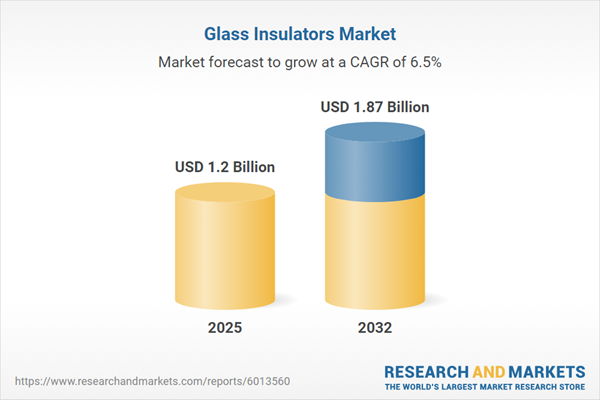Speak directly to the analyst to clarify any post sales queries you may have.
The glass insulators market plays a pivotal role in modern infrastructure, enabling organizations to secure operational reliability and future-proof networks amid ongoing modernization and evolving global supply chains.
Market Snapshot: Glass Insulators Market
The global glass insulators market is projected to grow from USD 1.13 billion in 2024 to USD 1.20 billion by 2025, with an anticipated compound annual growth rate (CAGR) of 6.48%. The market is expected to achieve a value of USD 1.87 billion by 2032. Driving this upward trajectory are persistent investments in grid modernization, the growing integration of digital technologies into utility operations, and evolving regulatory requirements that call for higher performance and compliance. As the supplier landscape adapts to the realities of tariffs and changing policy considerations, procurement models are evolving, placing greater emphasis on supply chain resilience and long-term planning for reliable infrastructure and seamless network performance.
Scope & Segmentation
- Product Types: Pin, post, shackle, and suspension insulators each support distinct technical demands, facilitating dependable operations across both standard and high-voltage environments in energy and transportation sectors.
- Voltage Classes: Options across low, medium, high, and ultra-high voltage cater to the diverse requirements of contemporary and legacy infrastructure projects, enhancing flexibility and safety for expanding utilities.
- Applications: Utilized in distribution lines, transmission grids, railway electrification, and substation buildouts, glass insulators are central to electrification initiatives and the proliferation of renewable energy integration worldwide.
- End Use Industries: Utility providers, major industrial operators, and renewable energy firms depend on glass insulators to maintain compliance, enhance operational efficiency, and reduce vulnerabilities within dynamic policy frameworks.
- Distribution Channels: Enterprises access glass insulators through direct procurement, OEM alliances, e-commerce solutions, and established distributor networks—allowing for strategic flexibility and project continuity across operational landscapes.
- Regions: The market encompasses the Americas, Europe, Middle East & Africa, and Asia-Pacific, each influenced by distinctive regulatory requirements, infrastructure investment priorities, and procurement practices.
- Technological Trends: Advanced sensor integration, compatibility with smart grid solutions, innovative glass composites, predictive maintenance systems, and sustainable manufacturing extend service life and drive sustainable outcomes.
Key Takeaways for Senior Decision-Makers
- Glass insulators undergird upgrades in critical energy and transportation networks, enabling organizations to align with modernization goals and evolving industry requirements.
- Choosing sustainable procurement strategies enhances organizational compliance and helps manage risk amid growing supply chain complexity and shifting market dynamics.
- Integrating sensor-enabled monitoring and analytics supports predictive maintenance, maintaining consistent uptime and optimizing network performance in operational environments.
- Establishing diverse and responsive supply chains prepares companies to meet policy-related challenges and fulfill the infrastructure needs of phased projects.
- Modular approaches improve resource allocation and allow leadership to manage project timelines efficiently while mitigating exposure to unnecessary risks.
- Staying attuned to regulatory changes and adopting strategic asset management bolsters enterprise agility and readiness for investment and operational adaptation.
Tariff Impact and Shifting Supply Chains
New U.S. tariffs on imported glass insulators prompt enterprises to reassess supplier networks and reinforce risk management practices. Many organizations are emphasizing sourcing models that favor regional or nearshore partners to address uncertainties tied to shifting geopolitical and cost pressures. Prioritizing long-term supplier relationships and securing agreements for raw materials have become critical in maintaining steady supply. Enhanced cross-functional collaboration between procurement and project management strengthens infrastructure schedules and helps build resilience across the entire network supply chain.
Methodology & Data Sources
This analysis is based on interviews with manufacturing leaders, procurement experts, and grid operators, supplemented by industry research, regulatory updates, patent filings, and international trade data. Scenario analysis explores the effects of structural supply chain changes and evolving policy landscapes on market trends.
Why This Report Matters
- The report equips senior executives with a comprehensive view of the glass insulators market’s segmentation, supporting informed decision-making.
- Practical guidance is included for monitoring regulatory and tariff impacts while refining supply chain strategies and strengthening risk mitigation.
- Recommendations address ways to build robust supplier networks, ensuring business continuity and adaptability throughout volatile market conditions.
Conclusion
The insights presented enable leaders to reinforce infrastructure stability, support long-term, sustainable growth, and foster continuous improvement through effective strategy and asset management.
Additional Product Information:
- Purchase of this report includes 1 year online access with quarterly updates.
- This report can be updated on request. Please contact our Customer Experience team using the Ask a Question widget on our website.
Table of Contents
3. Executive Summary
4. Market Overview
7. Cumulative Impact of Artificial Intelligence 2025
Companies Mentioned
The companies profiled in this Glass Insulators market report include:- NGK Insulators, Ltd.
- North American Insulators, Inc.
- Doğusan Insulators, Inc.
- ERCO Worldwide, Inc.
- SITEM S.p.A.
- Shanghai Haoxue Insulator Co., Ltd.
- Rosstec Insulators Private Limited
- Efacec Power Solutions S.A.
- Krosaki Harima Corporation
- Zhuhai Huaxin Ceramics Co., Ltd.
Table Information
| Report Attribute | Details |
|---|---|
| No. of Pages | 190 |
| Published | October 2025 |
| Forecast Period | 2025 - 2032 |
| Estimated Market Value ( USD | $ 1.2 Billion |
| Forecasted Market Value ( USD | $ 1.87 Billion |
| Compound Annual Growth Rate | 6.4% |
| Regions Covered | Global |
| No. of Companies Mentioned | 11 |









